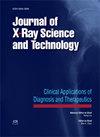Exploring value of CT coronary imaging combined with machine-learning methods to predict myocardial ischemia.
IF 1.4
3区 医学
Q3 INSTRUMENTS & INSTRUMENTATION
引用次数: 0
Abstract
PURPOSE To establish a machine-learning (ML) model based on coronary computed tomography angiography (CTA) images for evaluating myocardial ischemia in patients diagnosed with coronary atherosclerosis. METHODS This retrospective analysis includes CTA images acquired from 110 patients. Among them, 58 have myocardial ischemia and 52 have normal myocardial blood supply. The patients are divided into training and test datasets with a ratio 7 : 3. Deep learning model-based CQK software is used to automatically segment myocardium on CTA images and extract texture features. Then, seven ML models are constructed to classify between myocardial ischemia and normal myocardial blood supply cases. Predictive performance and stability of the classifiers are determined by receiver operating characteristic curve with cross validation. The optimal ML model is then validated using an independent test dataset. RESULTS Accuracy and areas under ROC curves (AUC) obtained from the support vector machine with extreme gradient boosting linear method are 0.821 and 0.777, respectively, while accuracy and AUC achieved by the neural network (NN) method are 0.818 and 0.757, respectively. The naive Bayes model yields the highest sensitivity (0.942), and the random forest model yields the highest specificity (0.85). The k-nearest neighbors model yields the lowest accuracy (0.74). Additionally, NN model demonstrates the lowest relative standard deviations (0.16 for accuracy and 0.08 for AUC) indicating the high stability of this model, and its AUC applying to the independent test dataset is 0.72. CONCLUSION The NN model demonstrates the best performance in predicting myocardial ischemia using radiomics features computed from CTA images, which suggests that this ML model has promising potential in guiding clinical decision-making.探讨CT冠状动脉成像结合机器学习方法预测心肌缺血的价值。
目的建立基于冠状动脉ct血管造影(CTA)图像的机器学习(ML)模型,用于评估冠状动脉粥样硬化患者的心肌缺血。方法回顾性分析110例患者的CTA图像。其中心肌缺血58例,心肌血供正常52例。将患者按7:3的比例分为训练数据集和测试数据集。采用基于深度学习模型的CQK软件在CTA图像上自动分割心肌并提取纹理特征。然后,构建7个ML模型对心肌缺血和心肌血供正常情况进行分类。分类器的预测性能和稳定性由交叉验证的接收者工作特征曲线决定。然后使用独立的测试数据集验证最佳ML模型。结果支持向量机极值梯度增强线性方法得到的准确率和AUC分别为0.821和0.777,神经网络方法得到的准确率和AUC分别为0.818和0.757。朴素贝叶斯模型的灵敏度最高(0.942),随机森林模型的特异性最高(0.85)。k近邻模型的准确率最低(0.74)。此外,NN模型的相对标准偏差最小(精度为0.16,AUC为0.08),表明该模型具有较高的稳定性,其应用于独立测试数据集的AUC为0.72。结论神经网络模型对CTA影像放射组学特征预测心肌缺血的效果最好,提示该模型具有指导临床决策的潜力。
本文章由计算机程序翻译,如有差异,请以英文原文为准。
求助全文
约1分钟内获得全文
求助全文
来源期刊
CiteScore
4.90
自引率
23.30%
发文量
150
审稿时长
3 months
期刊介绍:
Research areas within the scope of the journal include:
Interaction of x-rays with matter: x-ray phenomena, biological effects of radiation, radiation safety and optical constants
X-ray sources: x-rays from synchrotrons, x-ray lasers, plasmas, and other sources, conventional or unconventional
Optical elements: grazing incidence optics, multilayer mirrors, zone plates, gratings, other diffraction optics
Optical instruments: interferometers, spectrometers, microscopes, telescopes, microprobes

 求助内容:
求助内容: 应助结果提醒方式:
应助结果提醒方式:


